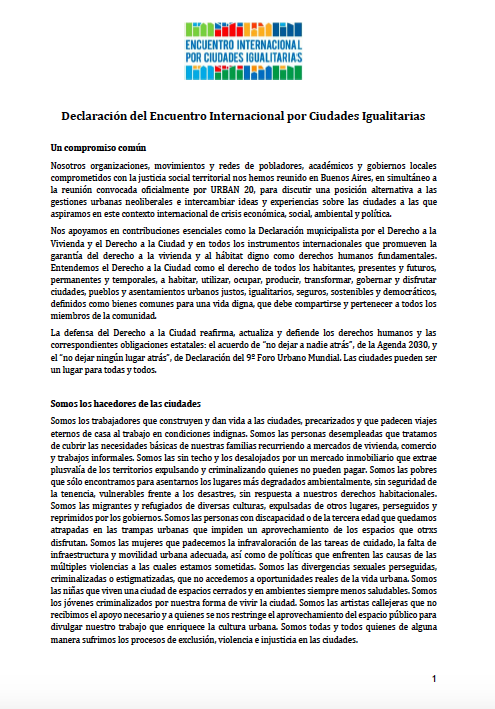[Excerpt of the introduction] Self-controlled housing: the key to the housing question The central focus of post-Engelian housing policy should not be property but rather decision-making. By denying the essential poiesis of the act of dwelling, the Engelian tradition made itself blind to the dialectic relationship between housing and economy. Far from being subserviant to them, self-administered housing is precisely the best means of placing limits on capitalist mechanisms, because a) it conserves housing, and therefore ‘use values’ in the downtown areas; b) it even occasionally manages to maintain a local land market at considerably lower prices than the speculative market. Far from being a superfluous adornment, the poiesis of the act of housing, or, if one prefers, self-administered activity centered on housing – as well as its rejection by dominant currents of both the liberal and the marxist tradition – provides a key to understanding the modern urban predicament. John Turner understood this more than anyone. Turner is a British architect who spent seven years in the marginal settlements of Peru in the 1960s and 1970s. Based on that experience, he endeavoured to formulate the principles of self-administered housing and popular urbanism. Of course, Turner did not express himself in the same terms as Holderlin and Heidegger! A practical man, careful at putting his ideas into the language of common understanding, he would have blushed at any mention of poetry, and even more at the use of Greek terms. He prefers, or at least, thirty years ago, preferred, to derive his metaphors from a system theory which, at that time, had still an aura of marginality. In 1994, such naïveté is no longer warranted. For that reason, paradoxically, I will begin this vindication of Turner with a criticism. Personally, I prefer to cite poets and philosophers rather than the founders of system theory, an ideology which today has become an obstacle to the intelligent understanding of daily life. Retrospectively, I see that the cost of referring to self-managed housing as essential poetry is less than that of speaking, as Turner did, of “feedback,” “self-reference,” “systems” and “sub- systems,” or even of “autopo/es/s,” all of which are technical terms borrowed from cyb-think. My criticism is, however, outweighed by the thankful recognition of my indebtedness. Turner made me see that housing is primordially an instrument or a vehicle toward existential ends whose fulfilment represents a flourishing of the individual and the community. Today, it would be self- defeating to cast this intuition in cybernetic metaphors or systemic analogies. The systemic uniquack that became fashionable after the – in that respect – naive sixties, contradicts all proposals of empowering people: a system is not an instrument because one does not use a system but rather one is integrated into it, one is made part of it and, finally, one is used by it. The three dimensions of the “housing question” Against Engels – and over and against the hidden curriculum of cyb-think – Turner maintains that the act of housing is essentially productive. As a contribution toward what Emilio Pradilla calls “the need to rescue the housing question from ideological fundamentalisms” (Pradilla, 1994), Turner has made an effort to find common ground with Engels’ followers, to whom he proposes the following reflection. The housing question can be discussed in a three-dimensional ‘space’. Each one of these dimensions can be viewed as the continuum – or spectrum – defined by two poles. These three pairs of poles cut across, or are transversal to old sets of opposites whose vestiges can only muddy the debate. They are: 1) the power equilibrium: pyramidal authoritarianism versus the principle of free association. These opposites confront opinions in ways that hardly correspond to old cleavages. On the one hand are all those, be they liberals or socialists, who believe that ‘more is always better’ and tomorrow’s gain is worth today’s sacrifice’. On the other are the ‘conservative anarchists’ who want to live here and now, and chose to be what they are, rather than trying to become something else. These two antagonistical groups lose sight of important perspectives. The first ignores the fact that planning is worthless unless it is based on a popular and shared idea of the social good. The latter The true debate should thus center on the question: To what degree is planning necessary and tolerable in a good society? Or, in the terms of two French authors (Dupuy and Robert, 1979): What is the inescapable minimum of heteronomy necessary for the exercise of autonomy? Philosophically, this question refers us to the difference between our relationships with others and with the domain of things. A table socially brings together the guests which it spatially separates: most interpersonal relationships need in a similar way the mediation of things. Buber explained this better than anyone else with his distinction between “l-Thou” and the “l-it” relationships (Buber, 1937). The good society is born from relationships between Ts’ and ‘Thou’s’. Planning recognizes that the existence of such relationships also depends upon the domain of things. But caution must be taken here (this warning is meant for authoritarian planners): planning only has meaning in regard to interpersonal relationships. Thus, writes Turner, “conservative anarchists like myself accept the necessity of central planning. But I might well accept the consequences of radical anarchism before submitting to the hegemony of the absolute collective with its frustration of personal fulfilment through the suppression of individual responsibility and relativity” (Turner, 1978, p. 1136). 2) the public vs. private appropriation of the means of production. These two poles define the state of the debate between 19th century capitalism and incipient socialism. Engels, dogmatic socialist, more ‘marxist’ than Marx himself, was opposed to the ‘petit bourgeois ideology’ of the private house ownership. And with it, he rejected all forms f traditional or modem domestic productivity. Actually, given the existential complexity and variability of real-life situations, the ownership of one’s house is frequently a vehicle of personal and collective self-realization (Coulomb, 1994). Yet, this is not always so: private ownership is only one modality among many forms of tenure. Principle opinions in favour of one extreme or the other are of little avail. It is better to increase effective options, multiplying the number of forms f tenure which are legally possible and existentially accessible, without neglecting these highs of access which cannot be strictly defined as either public’ or ‘private’ because they refer to community areas or commons, and permit forms of subsistence outside the cash nexus (Pucci, 1991). 3) the scale of the means of production. “I believe that in all contexts, a mix of small-scale ‘petty-commodity’ production and local cooperative enterprise is both vital and necessary; and in all contexts I believe that central planning and administration has to be limited to major infrastructures and to legislation limiting concentration of wealth and guaranteeing equitable access to locally scarce resources” (Turner, 1978, p. 1136). The tri-dimensional space defined by these three pairs of opposites (authoritarian-anarchic, public-private, large scale-small scale) provide a great variety of positions for individuals and coalitions. The Latin American experience shows us that people tend to occupy practically all the possible positions within this scheme, according to the specific priorities of the social, economic or even generational group to which they belong. It would be absurd to prevent a construction worker with three grown, partially unemployed but skilled children from ensuring his family’s security through the ownership of a self-built house, by arguing that someone who has recently arrived in the city should rent a place in a shelter. Still much sillier would be to oblige that same construction worker to produce cement in his backyard under the pretext that autonomy is best for him. But to use the opposite argument to condemn him to live in mass- produced prefabricated housing is not less absurd.
forgets that the Good Society depends in part on its antithesis, Planned Society.
Declaración del Encuentro Internacional por Ciudades Igualitarias
En el marco del U20, organizaciones sociales, movimientos populares, redes de la sociedad civil, integrantes de la academia y autoridades locales comprometidas con la igualdad, los derechos humanos y la sustentabilidad se reunieron en Buenos Aires para proponer un compromiso común por Ciudades Igualitarias.




